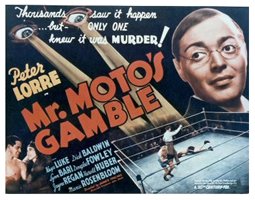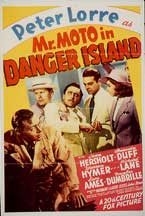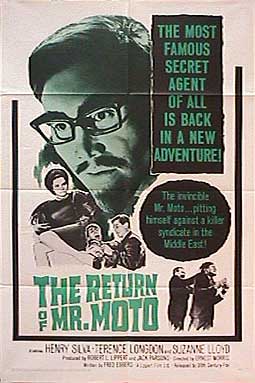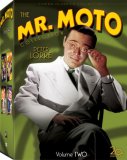| Reviews & Columns |
|
Reviews DVD TV on DVD Blu-ray 4K UHD International DVDs In Theaters Reviews by Studio Video Games Features Collector Series DVDs Easter Egg Database Interviews DVD Talk Radio Feature Articles Columns Anime Talk DVD Savant Horror DVDs The M.O.D. Squad Art House HD Talk Silent DVD
|
DVD Talk Forum |
|
|
| Resources |
|
DVD Price Search Customer Service #'s RCE Info Links |
|
Columns
|
|
|
Mr. Moto Collection, Vol. 2 (Mr. Moto's Gamble / Mr. Moto's Last Warning / Danger Island / Mr. Moto Takes a Vacation)
Those new to the Moto films prior to Fox's release of The Mr. Moto Collection, Volume One were probably expecting something like lesser Charlie Chan mysteries. Those films, starring Warner Oland as Charlie Chan, were being made simultaneously at Fox, were hugely popular in their day and have sold well in DVD boxed sets similar in design to the Motos. But the Moto films really weren't B-mysteries like the Chans, the Sherlock Holmes films at Fox and Universal, or the Thin Man movies over at MGM. No, the Motos were essentially early espionage thrillers, spy films with exotic settings, international intrigue and jujitsu action. Mr. Moto's Gamble was, however, the major exception to the rule.
As detailed blow-by-blow in "Mr. Moto meets Mr. Chan," one of the disc's extra features, Mr. Moto's Gamble was originally conceived as a Charlie Chan film, generally known as Charlie Chan at the Ringside. Swede Warner Oland, who had been playing the Chinese detective since 1931, was having severe personal problems and with nary a word walked off the set just a few days into production. After Fox executives briefly considered reworking the film around Chan's No. 1 son, Lee Chan (Keye Luke), they decided to instead refashion the screenplay as a Moto. The film that resulted is a curious patchwork, with Moto working within the confines of a more conventional (if still quite entertaining) mystery, spouting Chan-isms like "To reveal the snake, one must overturn the rug," and generally is much more subdued, less violent, less eccentric than the character is in all the other Moto films.
The revised script has Moto (Peter Lorre) teaching criminology classes, mainly to explain his relationship to two characters leftover from the original Chan screenplay, Lee Chan (Luke) and incorrigible kleptomaniac / ex-prizefighter "Knock-Out" Wellington ("Slapsie" Maxie Rosenbloom). Teaming Moto with Lee Chan was a neat idea, as the excitable, very American Lee contrasts nicely with the mysterious, measured Mr. Moto much like Lee had with his cautious and methodical father. Unfortunately, Lee spends most of his screentime teamed with Wellington, a singularly insufferable and unfunny comedy relief.
The story is rather similar to Charlie Chan at the Race Track (1936), with boxers and crooked fight managers instead of horses and bribed jockeys, though both feature hidden air guns. Rosenbloom's questionable charm aside, the film abounds in great character actors, many of whom go unbilled. Lon Chaney, Jr. has a small role and a few lines as gangster Nick Crowder's (Douglas Fowley) henchmen, Adventures of Superman's Perry White (John Hamilton) is one of the suspects, Ward Bond plays the over-confident heavyweight champ, and Paul Fix turns up as a would-be kidnapper. Others appearing with or without credit include Charles Williams (Cousin Eustace in It's a Wonderful Life), George Chandler, Olin Howland, and Fred Kelsey.
The plot has contender Bill Steele (Dick Baldwin) accused of murdering an opponent in the ring by soaking his gloves in a poison called collodion, but Mr. Moto knows better.
Mr. Moto's Last Warning has been widely available on tape and DVD owing to the fact that Fox apparently forgot to renew the picture's copyright in 1969 which meant that it's been in public domain ever since. It's not clear whether the restoration work Fox has put into the title legally protects it from being pilfered by bottom-feeder video labels looking for better masters of the film, but in any case the studio gets high marks for putting so much effort into a title that they might reasonably have left unrestored.
The film gets off to a clever start, with a Japanese man, not Lorre, passing himself off as Mr. Moto. (He's played by familiar - though not yet white-haired - Teru Shimada, who's credits include Tokyo Joe, Batman, and You Only Live Twice.) In fact the man is a double hired by Moto, who's in Egypt trying to stop international saboteurs from blowing up the French fleet to start a war between France and Britain.
Behind it all is a colorful and shrewd villain played by former silent star Ricardo Cortez (and who had been Sam Spade in the 1931 version of The Maltese Falcon) working incognito as a ventriloquist at a Vaudeville house/movie theater. Moto himself sets up shop as art dealer "Kuroki," and teams up with a stereotypical British twit on holiday, a clichéd role actor Robert Coote, early in his career, rises above. He makes it almost endearing.
Also in the cast is another recent British import, George Sanders, overdoing it here as a vaguely Slavic spy, and John Carradine in a bigger part than was his usual at this time, as a British spy working undercover. He has several nicely tense scenes with Cortez involving a diving bell.
The most significant thing about the next Moto is its title. Though generally known as Mr. Moto in Danger Island (sic), the onscreen title card reads "Peter Lorre as Mr. Moto in Danger Island" which, as far as this reviewer is concerned, means the title of the movie is Danger Island. Under any title this is the least of the original Moto movies, a by-the-numbers thriller. Officially a remake of 1934's Murder in Trinidad, this was supposedly conceived as yet another Charlie Chan film (the IMDb lists "Charlie Chan in Trinidad" as the original script title) and the pictures leans closer to that series and Mr. Moto's Gamble than the other Moto films. Who's responsible for the diamond smuggling through San Juan, Puerto Rico, threatening to turn the precious jewels market on its ear? Is it the always sinister Douglass Dumbrille (perhaps angry that Fox misspelled his name on the DVD case)**? Consistently shady Richard Lane? Frequently nefarious Leon Ames? Or could it be sweet, grandfatherly Jean Hersholt, Mr. Humanitarian Award himself?
Just as Fox gave its familiar backlot harbor set yet another workout in Danger Island, so too did the studio partner Moto with yet another less-than-bright sidekick. If Robert Coote was a major improvement over Max Rosenbloom, Warren Hymer's agreeably dense wrestler and Moto fan "Twister" McGurk proved the best yet, though in trying to fashion a companion for Moto like Lee Chan in the Charlie Chan films, Fox's writers were also trivializing the Moto character, robbing him of his ambiguity and eruptions of extreme violence against those who would do him in.
Here, Mr. Moto has been completely transformed into the benign, ever-polite Asian stereotype that the earlier films had steadfastly avoided. He's ready for action when the need arises, but mostly wide-eyed Lorre smiles broadly with those distractingly rotting teeth of his, which he wisely replaced with dentures after leaving Fox to become a contract player over the Hollywood Hills at Warner Bros. For some reason Lorre is especially bronzed up for much of the film, so much so that he's practically acting in blackface (yellowface?).
The film also lacks Norman Foster's Hollywood-authentic sense of locale. Where his Moto films (collected in Volume 1) have exotic settings, this film's Puerto Rico, which even the natives call Porto Rico, might as well be Patterson, New Jersey for the all the difference it makes.
Mr. Moto Takes a Vacation brings the series back on track for 63 breezy minutes, with Moto watching over the priceless crown of the Queen of Sheba, unearthed in Egypt and quickly transported to a museum in San Francisco. There, Moto suspects his own private Moriarty, the mysterious master criminal Metaxa, will try to steal it. Joseph Schildkraut (as museum patron Manderson), Lionel Atwil (as the museum's curator), Virginia Field (mysterious woman up to no good), and Victor Varconi (shady insurance investigator) are among the suspects, though film buffs will easily guess which way this one's headed early on.
Norman Foster, who directed all of the Motos in Volume 1, is back this time, and he lends the film a credibility lacking in the previous few entries, and Moto gets to don a disguise (as a Viennese archeologist) though once again Moto is saddled with another bumbling twit of a companion, insufferably played in this entry by G.B. Huntley.
The picture has some nice set pieces - wandering through the mummy exhibits after hours, a chase involving an extravagantly armored car - though some of the backlot streets representing Chinatown, with their 18th century buildings and cobblestones, look more like French Morocco than San Francisco.
The Return of Mr. Moto, released more than a year after Peter Lorre's death, is so threadbare and lackluster that it's almost fascinating to watch. The film may be terrible, but this reviewer for one is enormously pleased Fox saw fit to include it as an extra feature, though by all rights it deserves a bit more prominence on the packaging. As it is, many viewers might not even realize that it's included.
Though by 1965 most British and American films were being made in color and the B-movie (in the old Hollywood sense) had been dead since the early 1950s, The Return of Mr. Moto is in black and white and runs barely 70 minutes. (At the time, even bottom-of-the-bill filler was expected to have running times of 80-90 minutes.) The film was one of about a dozen produced in England by Lippert Films for release through 20th Century-Fox. Some, like this and Curse of the Fly (also 1965), were based on older, seemingly exhausted Fox properties, and several featured washed-up American talent (Lon Chaney, Jr. in Witchcraft, Brian Donlevy in Curse of the Fly, etc.) to lend the films some marquee value, but all were made on the cheap. Despite inflation and rising production costs, The Return of Mr. Moto was probably made for even less money than the original Motos; in terms of production, it resembles an episode of TV's The Saint or Danger Man.
The basic structure of its script and approach to the Moto character is actually pretty close to the original series - Moto at one point even disguises himself as "Mr. Takura," a stereotypical Japanese - but the execution is all wrong. Now an agent for Interpol, Mr. I.A. Moto (Henry Silva) investigates the murder of friend and former colleague (Gordon Tanner) and acts of sabotage being committed against Middle East oil fields managed by the "Shahrdar of Wadi Shammar" (Harold Kasket), a name which, amazingly enough, isn't supposed to be a joke. Also involved are a sadistic former-SS concentration camp officer, Dargo (Martin Wyldeck); Shahrdar's sinister assistant, Hussein (Marne Maitland); and Jonathan Westering (Terence Longdon, late of the "Carry On" series), an agent with MI5. For Sue Lloyd, it must have been humiliating going from The Ipcress File straight into this.
Silva had played a sinister if not terribly convincing North Korean agent in John Frankenheimer's superb The Manchurian Candidate three years before, but in that film adopted an accent and Asian eye makeup. This led to Asian-type roles on Voyage to the Bottom of the Sea and Wagon Train, but here Henry Silva is basically Henry Silva: no eye makeup, no accent, no nothin'. Maybe the filmmakers wanted to hedge their bets, perhaps hoping that by obscuring his nationality and race the film might both revive the Moto series for those nostalgic for one while attracting audiences clamoring for new spy pictures - any new spy pictures - amid the growing James Bond cult, then in full swing as The Return of Mr. Moto went into release.
But the picture is generic and utterly not compelling. The low budget and short shooting schedule is apparent throughout. It must have been shot in early 1965; some exteriors show a snow-covered London, while in other scenes set moments later, the streets are bare. A real giveaway is when Moto's colleague is gunned down at the beginning. Rather than use blanks the filmmakers resort to scratching the original negative to create, not at all convincingly, the flash of gunfire.
Video & Audio
The four original Moto pictures vary in quality from Very Good to Excellent, in full frame transfers that, in Fox's restoration comparisons show the effort the studio put into making these films shine. Contrast, sharpness, and steadiness are all excellent, as is the original mono audio (a 2.0 faux stereo mix is offered as well, along with Spanish and English subtitles). The single-sided discs are single-layered, except for the fourth disc containing The Return of Mr. Moto and other extras.
The Return of Mr. Moto is presented in 16:9 enhanced widescreen, at about 1.66:1, with very slight black bars on the left and right sides of the image. The print is very clean and, as stated earlier, is a welcome addition to the package even though the film is substandard. Though a subtitle menu isn't included, this extra feature likewise includes English and Spanish subtitles.
Extra Features
Each disc offers a generally well-made and informative featurettes, all in 16:9 enhanced widescreen and averaging about 15 minutes apiece. The best of these is Mr. Moto meets Mr. Chan: The Making of Mr. Moto's Gamble, a detailed account of the film's troubled production and actor Warner Oland's tragic meltdown. Charlie Chan fans will want to get this boxed set for Mr. Moto's Gamble and this featurette alone.
Mr. Moto's Last Warning includes an interesting featurette about Mr. Moto's creator, author John P. Marquand, while Danger Island has Meet Mr. Moto, an overview of the character and series.
Mr. Moto Takes a Vacation's extras include Moto is Missing, an 18-minute thumbnail sketch of Japanese militarism before, during, and after the Moto series, and how Lorre's increasing dissatisfaction with the character, falling profits, and growing anti-Japanese sentiment in the two years prior to their attack on Pearl Harbor all contributed to the series' end. (However, Lorre appeared on radio as Moto a few times after this, even after the war had begun.) The featurette leans heavily on screenwriter Bruce C. McKenna (Band of Brothers) and a riot of colorful but not very well organized newsreel, propaganda, and Japanese movie excerpts. Panned-and-scanned clips from a Mr. Moto story adapted without Mr. Moto in it, Stopover Tokyo (1957) are included.
The disc also includes a real surprise, an audio commentary by actor Henry Silva for The Return of Mr. Moto. At 79, Silva sounds great and has interesting things to say about the film.
Trailers for most of the Moto titles are included. The full frame trailer for The Return of Mr. Moto, like the film, is unforgivably sloppy, referring to him as that "swingin' Chinese cat with 900 lives!"
The packaging is nice, though one has to wonder about the source of some of the reviews quoted in the cover text. A "fast-moving mystery" says the General Federation of Women's Clubs of Mr. Moto's Gamble, while a review of Mr. Moto's Last Warning quotes something called the California Council of Federated Church Women. Well, if the California Council of Federated Church Women liked it, it's good enough for me!
Parting Thoughts
For B-movie mystery fans, The Mr. Moto Collection, Volume Two is a pricey but very worthwhile boxed set loaded with extras and nicely-restored feature presentations. Highly Recommended.
**A running time of 80 is also erroneously listed. The actual running time of the film is 69 minutes.
Film historian Stuart Galbraith IV's most recent essays appear in Criterion's new three-disc Seven Samurai DVD and BCI Eclipse's The Quiet Duel.
|
| Popular Reviews |
| Sponsored Links |
|
|
| Sponsored Links |
|
|
| Release List | Reviews | Shop | Newsletter | Forum | DVD Giveaways | Blu-Ray | Advertise |
|
Copyright 2024 DVDTalk.com All Rights Reserved. Legal Info, Privacy Policy, Terms of Use,
Manage Preferences,
Your Privacy Choices | |||||||
















